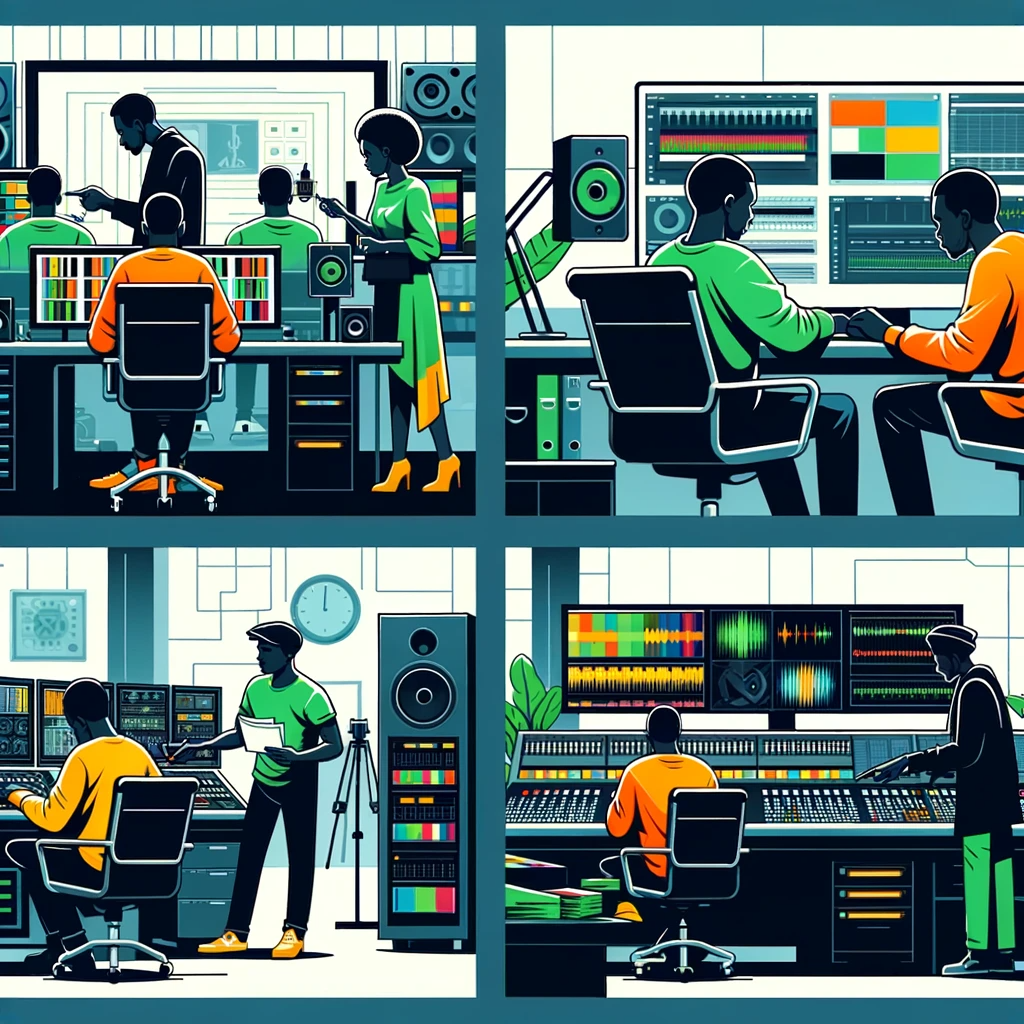Table of Contents
After filming concludes, post-production begins—the vital phase where raw footage is transformed into a compelling, finished film. In Nollywood, where technical ambition is rising alongside global attention, post-production is more than polishing—it’s storytelling in its final form.
This guide breaks down the key elements of post-production in Nollywood: editing, visual effects, sound design, color grading, and final delivery. Whether you’re an aspiring filmmaker or simply curious about what happens after “cut,” here’s how Nigerian films are shaped for the screen.
Unlocking the Essential Post-Production Phase
Post-production follows principal photography. It’s where all captured material is edited, enhanced, and finalized. This includes:
- Picture editing
- Sound design and mixing
- Color correction and grading
- Visual effects (VFX)
- Mastering and distribution prep
In early Nollywood, post-production was often rushed due to market pressures. But today, with filmmakers like Kunle Afolayan and others setting a new bar, careful post-production is central to the industry’s evolution.
The Art of Editing in Nollywood
Editing determines how a story unfolds. It’s the rhythm of the film—the difference between a forgettable moment and a powerful one.
Nollywood editors work with both speed and sensitivity. They navigate:
- Cultural storytelling patterns
- Genre expectations
- Tight turnaround times
Common techniques include:
- Rapid montages to show time passing
- Non-linear sequences in more dramatic or arthouse films
- Scene restructuring to improve flow under budget or time constraints
Even when resources are slim, Nigerian editors use creative tools like 2D transitions, rotoscoping, and reordering shots to craft coherent, emotional arcs.
Integrating Visual Effects Through Skill
VFX in Nollywood is growing—not through excess, but through precision.
Effects are often used for:
- Green screen backdrops and digital matte paintings
- Enhancing scenes with lightning, fire, smoke, or muzzle flashes
- Stylized 2D transitions and title sequences
Rather than chasing blockbuster visuals, Nollywood VFX teams focus on brief but impactful moments.
With more Nigerian VFX artists trained abroad returning to the local scene, access to world-class effects is expanding—often at lower costs.
Crafting Unique Soundscapes
Sound breathes life into film.
Post-production audio includes:
- Foley (footsteps, clothes rustling)
- Ambient noise (wind, traffic, environment)
- Dialogue cleanup and ADR
- Score and soundtrack mixing
Many Nollywood films incorporate traditional instruments and musical motifs to reflect culture while blending modern design techniques. This gives each film a unique sonic identity.
A well-mixed soundtrack can heighten emotion, build tension, or transport viewers—without flashy visuals

Enhancing the Visual Experience with Color Grading
Color grading creates visual cohesion across shots filmed at different times or with different cameras.
It helps:
- Correct inconsistencies in lighting or color
- Match genre tones (e.g., romantic warmth vs. horror coolness)
- Create mood and atmosphere
In Nollywood:
- Period films use sepia tones or film grain
- Contemporary stories lean into rich skin tones and cinematic saturation
- Experimental dramas sometimes play with filters or stylized looks
As post-production budgets grow, color grading is no longer optional—it’s an essential part of cinematic storytelling.
Streamlining Delivery in the Digital Age
Post-production managers oversee the entire flow—from rough cut to final export. Their job includes:
- Coordinating between editors, sound, and VFX teams
- Managing deadlines and equipment availability
- Preparing files for cinema, streaming, or TV delivery
Nigerian filmmakers now prepare for multiple delivery formats, from cinema DCPs to compressed files for streaming platforms like IrokoTV or Prime Video.
Well-managed delivery pipelines reduce delays, avoid formatting errors, and protect a film’s reputation.
Embracing New Post-Production Technology
Nollywood is evolving fast. Tools and trends shaping the future include:
- Cloud-based editing for remote teams
- AI-assisted tools for subtitles, color matching, and editing suggestions
- Real-time graphics for live compositing or virtual sets
- 4K+ resolution for films aiming at global platforms
These innovations aren’t just for Hollywood—they’re being adopted locally to stretch budgets, improve quality, and meet international standards.
Final Thoughts
Post-production is where Nigerian films become fully alive. It’s where pacing is refined, colors come alive, sounds find harmony, and effects add spark.
As Nollywood rises, investing in thoughtful post-production means more than polish—it means power.
If you’re a filmmaker, take this phase seriously. If you’re a fan, know that what you’re watching is the result of quiet artistry behind the scenes.
The final cut isn’t just an ending—it’s a new beginning.















Leave a comment